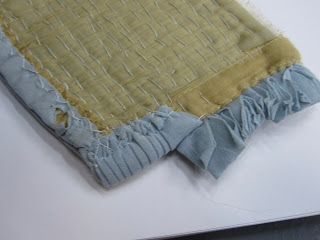Madame Gres (1903 – 1993) (pronounced Grey) was a Parisian couturier who created beautiful bias and pleated dresses, inspired by Grecian styles and lines. Her house, under the name of Gres, was opened in 1942 and she mainly used specially produced plain silk or wool jersey in golden beige, cream and red. During the Second World War, in Nazi occupied Paris, she made dresses with red, white and blue silk in an act of defiance, until they closed her down.
Although she was not commercially successful, becoming bankrupt in the 1980s, she discovered and developed techniques for draping on a custom dress form, the create fluidity, closely defined curves, and elegant shapes to flatter the female body. She didn’t always sketch her designs, but worked with yards and yards of silk chiffon or drapey jersey to create the structure and shape to enhance feminine curves. This would be done on the dress stand or directly on the wearer.

Let’s have a look at some of Madame Gres pleating close up. Tiny knife pleats are made in the fabric, each one pinned, to a roll or pad, along its length. Then the pleats are stitched down along their whole length, and finished neatly, to create a firm piece of fabric for the bodice. The lower end would be released to form the skirt.She avoided seams where ever possible.

The reverse of this piece shows how the piece was created. You can see the ribbon stay which prevents the pleats splaying out.

Here is a video about her work and exhibition, featuring Olivier Saillard. And a second rather poor quality video from Madame Pico who worked for Gres.
Gres produced a perfume, and also licensed some designs for Vogue and McCalls. Many of the patterns are of elegant structured day wear, but this marvellous draped evening dress is available as a digital reproduction in a large size.
I tried the Gres style pleating on the shoulders and across the sleeve of one of Nick’s “old” T shirts (not so old, and one of his favourites, but I liked the shape and colour). I will stitch these pleats down.

Here is another idea. I used a striped T shirt and gathered the fabric up fairly quickly, using the stripes for guidance. I will smock this T shirt, which has a skull pocket. I think the delicate “little girl” approach to smocking will contrast nicely with the darker shades, and slightly edgy look.

I have a few more transformations which I will share next week. Any one else making progress? In the meantime Sue Stoney has done a super job. Do go and have a look.


Linde
Oh Kate you have taken me back 40 years. Madame Gres was the favourite of my head tutor and so our class knew about her in depth. I remember trying my hand at all sorts of shapes and managed to make a pair of trousers with an extreme peg top waist . Madame Gres may not have been a household name and certainly never made a fortune but she truly was an artist.
Hélène
Thanks for this very interesting post, Kate! I like that, unlike Coco Chanel, she defied the Nazis during WWII, which makes her even more admirable as a person. I watched some videos about her in YouTube and also heard that her dresses were very comfortable to wear despite being closely fitted. I also heard that she didn’t know how to sew, and maybe this is why she avoided seams as much as possible? I don’t know but her work is truly stunning. As for my take on your transform a tee sew-along, I have found two appropriate XXL tees at the op-shop and will tackle the first one over the week-end. I’ve had plenty of ideas. Let’s hope that at least one of them will work!
Ellen Miller
Looks like fun! I will jump into T-shirt remake mode as soon as I finish the current projects. Have you the You-Tube videos of an artist cutting and weaving the backs of T-shirts while women are wearing them?
I wrote about Smocking in Creating Couture Embellishments and really enjoyed making all the samples for that chapter. Also: Ruching (gathering fabric on one side of the panel but not the other) and Pleating, including cartridge pleats (very tightly gathered pleats) can be found in the book. Maybe some of the photos in the book will inspire T-shirt remakes!
Bunny
Her stunning work has always fascinated me. I’ve also found it quite interesting how a smocking pleater can make similar tiny, tubular pleats and always wondered if there were some way to make the process easier by using one. Great post, Kate.